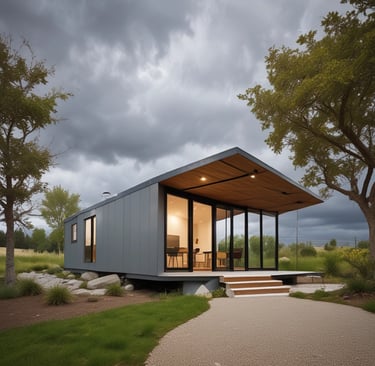What Makes a Prefab Home Storm-Resistant?
11/22/20257 min read


Introduction to Prefab Homes and Their Advantages
Prefab homes, also known as prefabricated homes, represent a growing trend in the modern housing market, driven by their unique construction methods and numerous advantages. These homes are built off-site using standardized components that are then transported and assembled at their final location. This innovative approach to construction has led to increased popularity, particularly among those seeking efficient and economical housing solutions.
One of the primary benefits of prefab homes is cost efficiency. By streamlining the construction process and reducing labor costs, these homes often present a more affordable option compared to traditional housing. This cost-effective nature, combined with the ability to customize designs to meet individual preferences, has attracted a diverse range of buyers. Prefab homes can be tailored to include specific features, materials, and layouts, making them an appealing choice for homeowners looking to create a personalized living space.
Furthermore, the speed of construction is a significant advantage of prefab homes. Traditional building methods can require extensive time commitments, ranging from several months to years for completion. In contrast, prefab homes can often be constructed in a matter of weeks. This rapid assembly not only saves time but also allows homeowners to move into their new residences more quickly. Such efficiency is particularly attractive in today’s fast-paced world.
Finally, sustainability is a crucial aspect of prefab homes. Manufacturers increasingly focus on utilizing eco-friendly materials and energy-efficient designs, resulting in homes that contribute positively to the environment. As climate-related challenges intensify, the demand for robust and sustainable housing solutions has surged, making prefab homes a timely choice for environmentally-conscious consumers.
Understanding Storm Resistance in Homes
Storm resistance in homes is a critical consideration for homeowners, particularly in areas prone to severe weather events. It refers to the ability of a residential structure to withstand the destructive forces associated with storms, including hurricanes, tornadoes, and heavy thunderstorms. Various factors contribute to a home’s storm resistance, encompassing design principles, materials, and engineering practices that prioritize safety and durability.
The design of storm-resistant homes often incorporates aerodynamic shapes that reduce wind pressure against the structure. For instance, a rounded or sloped roof can effectively minimize uplift during high winds. Homes designed with a low profile can also mitigate wind loads, enhancing their overall resilience. Additionally, buildings are engineered to have a strong foundation, which is vital in ensuring stability during storms that may lead to flooding or ground saturation.
Materials play a significant role in a home’s ability to resist severe weather. High-strength materials such as reinforced concrete, structural steel, and impact-resistant windows can significantly improve a home’s performance against strong winds and flying debris. Innovative building materials that are both lightweight and durable, such as engineered wood, also contribute to the resilience of a structure while maintaining energy efficiency.
The engineering practices adopted in storm-resistant home construction are crucial to achieving maximum safety. This includes rigorous adherence to local building codes that establish minimum requirements for the design and materials used in home construction. Furthermore, the incorporation of advanced technologies such as hurricane straps and reinforced doors can significantly enhance a home's ability to withstand severe weather events. Ultimately, understanding these elements of storm resistance is essential for homeowners looking to safeguard their properties against the unpredictable forces of nature.
Key Features of Storm-Resistant Prefab Homes
Storm-resistant prefab homes are designed with a variety of key features that enhance their robustness against extreme weather conditions. One of the primary characteristics is strong structural design. This involves employing advanced engineering techniques and principles to ensure that the homes can withstand high winds and lateral forces associated with severe storms. The use of reinforced materials further enhances the overall durability of these homes. Materials such as steel framing, concrete, and high-strength wood are commonly utilized to create a resilient structure.
Another critical aspect is the elevated foundation. Prefab homes are often built on pilings or raised platforms, which helps protect them from flooding and rising water levels. Elevation minimizes the risk of water damage during hurricanes and heavy rainstorms, thereby prolonging the life of the home and increasing safety for the occupants. Additionally, the aerodynamic shape of these homes plays a significant role in storm resistance. Homes designed with streamlined contours are better equipped to deflect wind, reducing pressure on the structure during high-velocity storms.
The implementation of impact-resistant windows and roofing is essential in storm-resistant design. Windows are often made using laminated glass or polycarbonate materials that can withstand flying debris. Similarly, roofing materials are chosen specifically for their ability to endure heavy winds and impact forces. These windows and roofs work seamlessly to create a fortified envelope around the home, further protecting it in adverse weather conditions. Collectively, these features work in harmony to enhance the storm resilience of prefab homes, making them a viable option for those living in regions prone to extreme weather events.
Building Codes and Standards for Storm-Resistant Construction
In the realm of storm-resistant construction, building codes and standards play a crucial role in ensuring the safety and durability of prefab homes in the face of extreme weather events. Different regions are subject to specific regulations developed to address the unique challenges posed by local environmental conditions, such as hurricanes, tornadoes, and floods. These codes are designed to minimize risks, enhance resilience, and promote safety in any residential building, including manufactured structures.
At the forefront of storm-resistant guidelines are the Federal Emergency Management Agency (FEMA) recommendations. FEMA's guidelines provide comprehensive protocols for construction in flood-prone areas, emphasizing elevation, materials selection, and design strategies to mitigate flood damage. In regions subject to high winds, additional standards, such as those outlined in the International Building Code (IBC) and ASCE 7, detail requirements for wind resistance, focusing on roof designs, anchorage, and exterior finishing materials to withstand windborne debris.
Furthermore, local building authorities often implement additional regulations, such as wind zone classifications that dictate the level of structural reinforcement necessary depending on the anticipated wind speeds in the area. Compliance with these standards is mandatory for prefab homes to ensure they meet safety benchmarks and can withstand natural forces effectively. The importance of adhering to these codes cannot be understated, as they not only serve to protect lives but also reduce long-term financial losses associated with repairs and reconstruction following damaging events.
In summary, understanding the intricate tapestry of building codes and standards dedicated to storm-resistant construction is essential for the effective design and implementation of prefab homes. As climate change continues to influence the frequency and severity of severe weather, strict compliance with these regulations will be vital in fostering resilient communities.
Case Studies of Successful Storm-Resistant Prefab Homes
Examining real-world examples of prefab homes that have withstood severe storm conditions can provide valuable insights into the effectiveness of storm-resistant design techniques. One notable case is a prefab home built in a coastal region of Florida, where hurricanes frequently threaten residences. Utilizing reinforced concrete panels, this home demonstrated exceptional resilience during Hurricane Irma in 2017, which produced wind speeds exceeding 100 mph. The combination of aerodynamic design and bolted connections prevented structural failure, allowing the home to remain largely unscathed.
Another compelling example can be found in Louisiana, where a prefab home constructed to meet local flood resilience standards successfully withstood the impacts of Tropical Storm Harvey. This home was elevated on stilts, permitting the floodwaters to flow underneath rather than through the structure. Made with water-resistant materials, the prefab home not only survived the storm but also minimized damage from flooding, showcasing effective storm-resistant design.
In a more southern state, a prefab dwelling in Texas faced a severe tornado that rated EF3 on the Enhanced Fujita scale. The home integrated a unique bracing system constructed with steel frames and impact-resistant windows. This design choice proved indispensable, as it kept the integrity of the walls intact amidst swirling debris and high winds. Homeowners reported minimal damage; thus, exemplifying the potential of storm-resistant prefab architecture.
These case studies highlight various strategies for creating prefab homes capable of enduring storm conditions. The use of innovative materials, elevated foundations, and specialized designs play a crucial role in enhancing the storm resistance of these structures. Each example serves as a model for future construction, illustrating that prefabrication can not only offer efficiency but also enhance safety and durability in storm-prone areas.
Challenges and Limitations of Prefab Home Storm Resistance
While prefab homes are often lauded for their efficiency and adaptability, challenges and limitations exist, particularly when it comes to storm resistance. One significant factor is the cost implications associated with constructing a storm-resistant prefab home. Although the initial purchase price of a prefab home can be lower than traditional builds, enhancing its storm-resistant features—like reinforced walls, impact-resistant windows, and elevated foundations—can drive costs up substantially. Homeowners must weigh these additional expenses against the potential long-term benefits of safety and durability.
Furthermore, site-specific challenges can complicate the design and installation processes of prefab homes in storm-prone areas. Factors such as local building codes, environmental regulations, and land characteristics must be taken into account. For instance, areas subject to hurricanes require specific design considerations to withstand high winds and flooding, which may not align with standard prefab offerings. Buyers should engage with professionals familiar with the local landscape to ensure compliance and structural integrity.
Potential drawbacks of certain materials and designs also merit attention. While many prefab homes utilize modern materials that offer energy efficiency, they may not all be optimal for severe weather conditions. For example, lighter materials may be cost-effective and easier to transport; however, they may lack the resilience necessary to endure heavy wind and debris from storms. Homeowners should conduct thorough research and consider advanced materials that provide better resistance to natural disasters.
In conclusion, while prefab homes present numerous advantages, those interested in storm-resistant designs must navigate their inherent challenges and limitations. A comprehensive understanding is essential for making informed decisions that prioritize safety and sustainability in storm-prone environments.
Conclusion and Future Trends in Storm-Resistant Prefab Homes
In recent years, the significance of storm resistance in prefab homes has garnered increasing attention, largely due to the growing frequency and severity of extreme weather events. Prefabricated construction offers unique advantages, including efficient building processes and cost savings, while also paving the way for enhanced resilience against storms. Understanding the importance of robust designs and materials in prefab homes can help mitigate the disastrous impacts of hurricanes, tornadoes, and other natural calamities. Key takeaways from our discussion highlight the necessity for durable structures that not only comply with building codes but are also designed explicitly with storm resilience in mind.
Looking ahead, several trends are emerging in the realm of storm-resistant prefab homes. Advancements in materials science are driving innovation, resulting in stronger and more versatile materials that can withstand severe weather conditions. For instance, the development of impact-resistant windows and doors, coupled with materials that are more resistant to moisture and decay, significantly enhances the durability of homes in storm-prone areas. Furthermore, the integration of innovative construction techniques, such as modular designs and anchored foundations, promises to fortify the structural integrity of prefab homes against extreme weather forces.
Another noteworthy trend is the emphasis on sustainable building practices within the prefab sector. Eco-friendly materials and energy-efficient designs not only contribute to storm resistance but also reduce the overall environmental impact of construction. As climate resilience becomes an imperative, especially in coastal and vulnerable regions, prefab homes stand out as a viable and compelling option for homeowners. By investing in storm-resistant prefab homes, individuals can safeguard their properties while navigating the challenges posed by an unpredictable climate. This blend of resilience and sustainability makes the future of prefab homes particularly promising.
